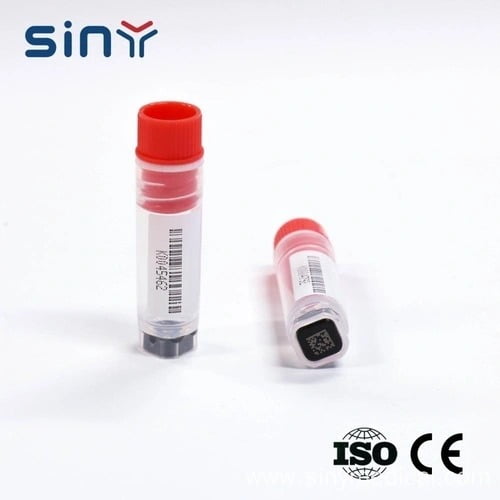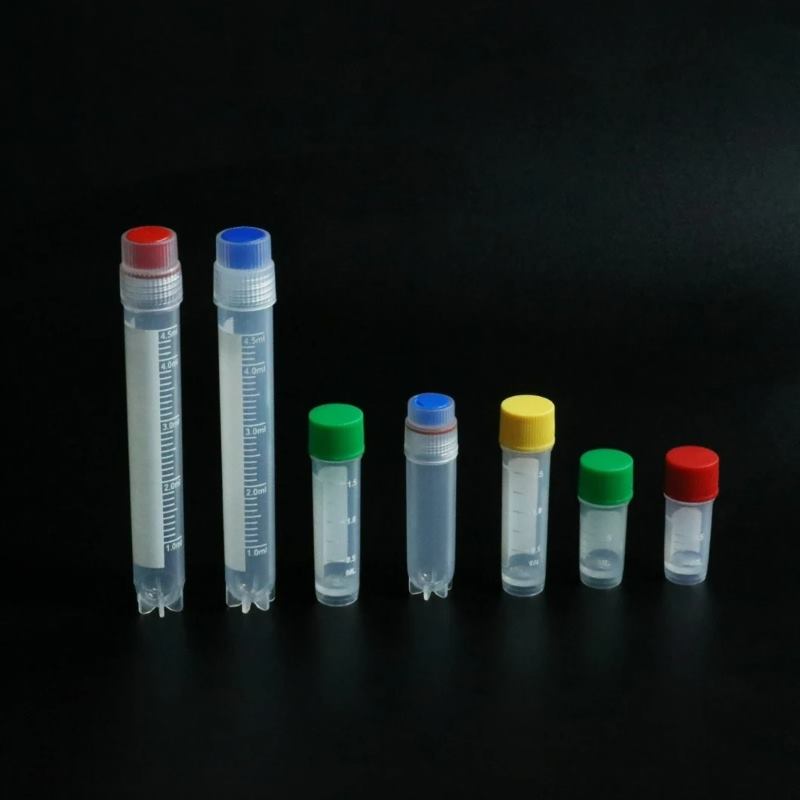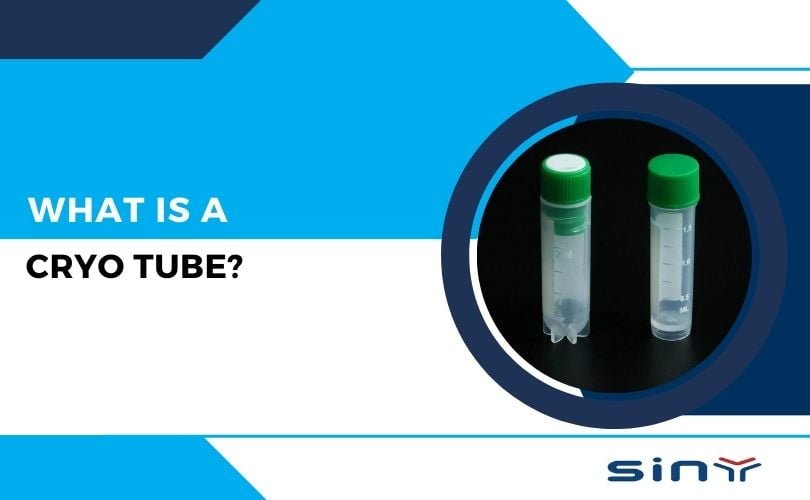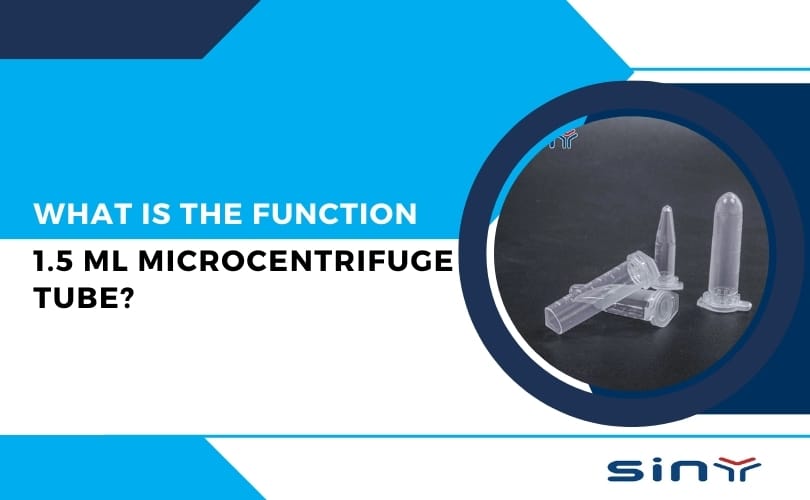A cryotube is a container used to store biological samples at low temperatures.
It is widely used in life science research, medicine, biotechnology and other fields to store biological samples such as cells, tissues, bacteria, viruses, biological products, and active enzymes. In a low-temperature environment, it can effectively extend the sample’s storage time while maintaining its biological activity and stability.
Table of Contents
What is a Cryotube?
Cryotubes, called cryogenic tubes, are specialized storage containers designed to store biological samples at extremely low temperatures safely. These tubes are critical in many scientific and medical fields, providing a reliable means for preserving cells, tissues, enzymes, DNA/RNA, and other biological materials. By maintaining these materials at sub-zero temperatures, typically between -80°C to -196°C, cryotubes ensure that biological specimens remain viable for extended periods, enabling long-term storage and future research or clinical use.

Material
They are usually made of low-temperature-resistant materials, such as polypropylene. These materials are not easy to break or deform at low temperatures and can ensure the safety of the sample.
The tube cap and body seal well, preventing sample leakage and external substances from entering.
Capacity
Many different capacity specifications, such as 1ml 1.5ml 2ml 5ml, can be selected according to the sample size.
Label
The tube body usually has a scale and label area to facilitate users in recording sample information, such as sample name, number, storage date, etc.
What are the differences between cryotubes and centrifuge tubes?
There are differences between cryotubes and centrifuge tubes in the following aspects:

Use
Cryotubes: They are mainly used for the cryopreservation of biological samples, such as cells, tissues, bacteria, viruses, biological products, etc. In ultra-low temperature environments (usually liquid nitrogen or ultra-low temperature refrigerators), samples’ biological activity and stability can be maintained for a long time.
Suitable for situations where samples need to be stored for a long time or where high requirements are placed on sample storage conditions.
Centrifuge tubes: Centrifuge tubes are mainly used for centrifugal operations in laboratories, where substances of different densities are separated by high-speed centrifuge rotation.
It can also store, mix, and transfer liquid samples but is generally not for ultra-low temperature storage.
Material
Cryotubes: Usually made of low-temperature resistant materials, such as polypropylene, which can maintain good physical properties at extremely low temperatures and will not break or deform due to low temperatures.
Centrifuge tubes: Made of various materials, including plastics (polypropylene, polyethylene, etc.) and glass. Centrifuge tubes of different materials are suitable for different experimental needs.
Sealing
Cryotubes: The sealing requirements between the tube cap and the tube body are very high to prevent liquid nitrogen from penetrating the tube and sample leakage. Usually, a unique sealing design is used, such as rubber gaskets, screw caps, etc.
Centrifuge tubes: The sealing is relatively low, and the sealing is generally achieved by simply snapping the tube cap and the tube body or spiral connection, mainly to prevent the liquid from overflowing during the centrifugation process.
Capacity
Cryopreservation tubes: The capacity is relatively small, and standard specifications include 1ml, 2ml, 5ml, etc., to meet the small amount of biological sample storage needs.
Centrifuge tubes: The capacity range is vast, from 0.5ml to 50ml or even more significant, and the appropriate capacity can be selected according to different experimental needs.
How to use cryopreservation tubes?
1. Make sure the cryopreservation tubes are clean, dry, and free of any contaminants. According to the sample type and storage requirements, select a suitable protective agent, such as glycerol or DMSO, and mix the sample and protective agent evenly before loading into the cryopreservation tube.
2. Freezing Process
A programmed cooling method or rapid freezing method can be used. The programmed cooling method is to place the cryopreservation tube in a programmed cooling box and gradually lower the temperature according to the set cooling rate until the required low temperature is reached;
The rapid freezing method directly puts the cryopreservation tube into cryo tube for liquid nitrogen for fast cooling.
3. Storage
The frozen cryopreservation tube is transferred to a low-temperature refrigerator or liquid nitrogen tank for long-term storage. During the storage process, it is essential to regularly check the temperature and operating status of the equipment to ensure that the sample is always in a suitable low-temperature environment.
4. Removal and use
When removing the cryopreservation tube from the low-temperature equipment, it should be quickly placed in a 37°C water bath for rapid thawing. During the thawing process, the cryopreservation tube should be gently shaken continuously to heat the sample evenly and avoid local overheating, causing damage to the sample.
What are the precautions for using cryopreservation tubes?
Safe operation
Appropriate protective equipment, such as gloves and goggles, should be worn when operating at low temperatures to prevent frostbite.
Low-temperature substances such as liquid nitrogen are dangerous. When using them, the operating procedures must be strictly followed to avoid accidents.
Sample Quality
Ensure the quality and purity of the sample and avoid storing contaminated samples in cryopreservation tubes.
According to the sample type and preservation requirements, appropriate protective agents and freezing methods must be selected to maximize the biological activity of the sample.
Cryopreservation tube quality
Select cryopreservation tubes with reliable quality to ensure good sealing and low-temperature resistance. A sealing test can be performed before use.
Record management
Keep detailed records of samples stored in cryopreservation tubes, including sample name, number, storage date, source and other information. Establish a complete sample management system to facilitate the query and use of samples.
Cryotube vs. Centrifuge Tube: Key Differences
While cryotubes and centrifuge tubes might seem similar, they are designed for different purposes:
- Use and Application:
- Cryotubes are specifically designed for cryogenic storage, maintaining biological samples at ultra-low temperatures over long periods.
- Centrifuge tubes are primarily used to separate the components of a mixture by density through high-speed spinning in a centrifuge. They can also be used for storing, mixing, and transferring liquids but are unsuitable for ultra-low temperature storage.
- Material and Durability:
- Cryotubes are made from materials like polypropylene, which are chosen for their resistance to cracking and deformation at low temperatures.
- Centrifuge tubes can be made from various materials, including glass and different plastics, depending on the specific requirements of the experiment.
- Sealing Mechanisms:
- Cryotubes have high sealing requirements to prevent liquid nitrogen from penetrating and to avoid sample leakage. They often use specialized sealing designs, such as rubber gaskets or screw caps.
- Centrifuge tubes have less stringent sealing needs, often using simple snap-on or screw caps to prevent spillage during centrifugation.
- Capacity Variations:
- Cryotubes are available in smaller capacities, typically between 0.5 and 5 ml, to meet the needs of storing small biological samples.
- Centrifuge Tubes come in a broader range of sizes, from 0.5ml to 50ml or more, to accommodate different experimental needs.
Conclusion
Cryotubes are a vital component in the toolkit of any laboratory or clinical setting that requires the long-term storage of biological samples at ultra-low temperatures. Their ability to preserve samples’ biological activity and stability makes them indispensable in scientific research, clinical diagnostics, and biotechnological development. Understanding their proper use and the precautions required for handling them ensures that cryotubes can effectively support advancements in science and medicine.
FAQs
What is a cryotube used for?
A cryotube is used to store biological samples, such as cells, tissues, bacteria, viruses, proteins, enzymes, and other biomolecules. It preserves these samples at ultra-low temperatures, typically in liquid nitrogen (-196°C) or ultra-low temperature freezers (-80°C). Cryotubes are essential in scientific research, clinical diagnostics, and biotechnology for the long-term storage of biological materials while maintaining their viability and integrity.
What materials are cryotubes made from?
Cryotubes are typically made from polypropylene, a type of plastic known for its resistance to extremely low temperatures and durability. This material is selected because it does not crack or deform when exposed to the ultra-cold conditions of cryogenic storage.
How do cryotubes differ from centrifuge tubes?
Cryotubes and centrifuge tubes serve different purposes. Cryotubes are designed for long-term storage of biological samples at ultra-low temperatures, with high-quality sealing to prevent contamination and sample degradation. Centrifuge tubes, on the other hand, are used to separate substances based on density through high-speed spinning in a centrifuge.
Can cryotubes be reused?
Cryotubes are generally designed for single-use to prevent cross-contamination and ensure the purity of samples. While some laboratories may choose to sterilize and reuse cryotubes, this practice is not recommended due to the increased risk of contamination and the potential degradation of the tube material after repeated freezing and thawing cycles.
How should cryotubes be labelled?
Proper labelling of cryovial cryotubes is essential for effective sample management. Each cryotube should be labelled with crucial information such as the sample name or identifier, storage date, sample type, and experimental conditions or treatment details. Many cryovial come with designated labelling areas or can be used with pre-printed labels or barcodes.
What is the best way to thaw samples stored in cryotubes?
The recommended method for thawing samples stored in cryotubes is rapid thawing in a 37°C water bath. This method minimizes the risk of ice crystal formation, which can damage cells and tissues.
How do you ensure the quality of cryotubes?
To ensure the quality of cryotubes for liquid nitrogen, choosing tubes that meet stringent manufacturing standards for low-temperature resistance and sealing is essential. Test cryotubes to ensure they withstand repeated freezing and thawing cycles without leaking or cracking.



























































